
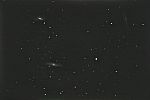 NEW! Images by Steve Luzader
NEW! Images by Steve LuzaderThe left picture shows M65 (right of center) and M66 (lower left corner) in the constellation of Leo. M65 is about 35 million light years away and M66 is about 36 million light years from us. The right image shows the Leo Triplet, which is M65, M66, and NGC3628 (barely visible in the upper right corner). 3628 is about 35 million light years away. Both images were made with a Canon 40D on a Celestar 8. The M65-66 image is a stack of 4 2-minute exposures at f10, ISO1600. The Triplet image is a stack of 10 2-minute exposures at f6.3, ISO800. The 40D frames were stacked using Deep Sky Stacker (which insisted on treating them as gray scale images even though they were shot in color) and the stack was further processed using Paint Shop Pro 7. The f6.3 image had severe vignetting, which was removed using the "flat field" technique described by Sean Walker in the September 2001 Sky & Telescope.
 Image by Dan Rose
Image by Dan RoseAn image of M51 showing supernova SN2011dh. The picture was taken at Stars in the Park in Frostburg's Parris Glendening Recreation Complex on July 30,2011.
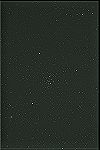 Photo by Steve Luzader
Photo by Steve Luzader
A photo of M44 (The Beehive Cluster) in Cancer taken on March 4,
2009. This is a piggyback shot taken with a Canon 40D SLR fitted with a
28-135 mm zoom lens set for 135 mm at f/6.3.
The image is a sum of five 1-minute exposures taken at ISO
1600. Comet Lulin is visible at the lower left of the image.
 Photo by Steve Luzader
Photo by Steve LuzaderA color photo of M45 (The Pleiades) in Taurus. This is a piggyback photo taken with a 70-210 mm zoom lens set for 210 mm at f/4. The exposure was 15 minutes exposure on Kodak ASA800 color negative film. Some of the nebulosity around the members of the cluster is visible. Unfortunately, I realized near the end of the exposure that the camera was looking through some tree branches, which give the cluster the appearance of being in a box.
 Photo by Steve Luzader
Photo by Steve Luzader
A color photo of M16 (the Eagle Nebula) in Scutum. This is a 20-minute exposure
on Fuji ASA 800 color negative film through an 8-inch SCT at f/6.3
taken at the 2004 Blackwater Falls Astronomy Weekend. The negative was
scanned and processed with Paint Shop Pro.
 Photo by Steve Luzader
Photo by Steve Luzader
A color photo of M11 (the Wild Duck Cluster) in Aquila. This is a 10-minute
exposure on Fuji ASA 800 color negative film through an 8-inch SCT at f/6.3.
The negative was scanned and "flat-field" processed with Paint Shop
Pro.
 Image by Steve Luzader
Image by Steve Luzader
M39 in Cygnus. This is a 10-minute exposure on Fuji ASA 800 color negative
film through an 8-inch SCT at f/6.3.
 Image
by Steve Luzader
Image
by Steve Luzader
A picture of M1 (the Crab Nebula) taken from my driveway with the SBIG STV
imager. This was a series of 6 exposures of 20 seconds each taken with an
8" SCT at f/10.
 STV
image by Steve Luzader
STV
image by Steve Luzader
M3 in Canes Venatici. The image was made with my SBIG STV camera. It's a track-and-accumulate
composite of two 10 second exposures taken with an 8-inch SCT at f/6.3. The
camera was set for "Normal" display mode.
 Photo by Steve Luzader
Photo by Steve Luzader
Antares and M4 in Scorpius. The photo was made using an 80 mm (aperture) Orion
"Short Tube" refractor at f/5 riding piggyback on an 8-inch SCT that was used
for guiding. The exposure was 19 minutes on Fujichrome Sensia 100 slide film.
The original image (taken in June 1997) showed vignetting
and a strong overall blue cast. I reprocessed the slide with Paint Shop Pro
using the "flat field" technique described by Sean Walker in the
September 2001 Sky & Telescope. Now the sky is black and
Antares has regained its ruddy color!
 STV
image by Steve Luzader
STV
image by Steve Luzader
M5 in Serpens. The image was made with my SBIG STV camera. It's a track-and-accumulate
composite of two 20 second exposures taken with an 8-inch SCT at f/6.3. The
camera was set for "Normal" display mode.
 Photo
by Gus Johnson
Photo
by Gus Johnson
M6 and M7 in Scorpius. The exposure was 2.5 minutes with a 250 mm lens at
f/4.5 on Kodak Gold 400 color negative film. Altazimuth tracking was used.
 STV
image by Steve Luzader
STV
image by Steve Luzader
M11, the "Wild Duck Cluster", in Aquila. This is a track and accumulate
composite of four 10-second exposures with my STV imager using an 8-inch SCT
at f/6.3. The STV image was enhanced using AIP4Win.
 STV
Image by Steve Luzader
STV
Image by Steve Luzader
M13 in Hercules. The image was made with my SBIG STV camera. It's a 15 second
exposure taken with an 8-inch SCT at f/6.3. The camera was set for "Normal"
display mode.
 STV
image by Steve Luzader
STV
image by Steve Luzader
M14 in Ophiucus. This is a track and accumulate composite of four 20-second
exposures with my STV imager on my 8" SCT at f/6.3. The STV image was
enhanced using AIP4Win.
 Photo
by Steve Luzader
Photo
by Steve Luzader
M15 in Pegasus. The exposure was 15 minutes on Fujicolor Superia 400 negative
film at prime focus of my 8-inch SCT at f/10. The telescope was guided by
my STV imager.
 Photo
by Rob Himmler
Photo
by Rob HimmlerM16 (the Eagle Nebula, top) and M17 (the Omega Nebula, bottom) in Sagittarius. The exposure was 20 minutes on Ektachrome 200 slide film with a 120 mm wide field refractor at f/4.
 STV
image by Steve Luzader
STV
image by Steve Luzader
The interior of M16, the Eagle Nebula, in Sagittarius. This is a track and
accumulate composite of four 30-second exposures with my STV imager on my
8" SCT at f/6.3. The STV image was enhanced using AIP4Win. The image
shows the dust columns made famous by a spectacular Hubble Space Telescope
picture.
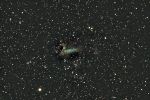 Photo
by Steve Luzader
Photo
by Steve Luzader
M17 (the Omega Nebula) in Sagittarius. The exposure was approximately 20 minutes
on Fujicolor Superia 400 color negative film taken with an 8-inch SCT at f/6.3.
The exposure was guided by my SBIG STV.
 STV
image by Steve Luzader
STV
image by Steve Luzader
M17 in Sagittarius. Compare with the color image above. This closeup is a
track and accumulate composite of five 20-second exposures with my STV imager
on my 8" SCT at f/6.3. The STV image was enhanced using AIP4Win.
 Photo
by Steve Luzader
Photo
by Steve Luzader
M20 (The Trifid Nebula) in Sagittarius. The exposure was approximately 20
minutes on Fujicolor 200 color negative film taken with an 8-inch SCT at f/6.3.
The image shown here was cropped from the negative. The image shows two distinct
nebular features--the red color of emission from hydrogen gas excited by light
from stars within that part of the nebula, and a fainter blue color resulting
in reflection of light from stars outside that part of the gas cloud.
 Photo
by Steve Luzader
Photo
by Steve Luzader
For comparison with the photo above, here's another image of M20. This exposure
was 20 minutes on Fujicolor Superia 400 color negative film taken with an
8-inch SCT at f/6.3. The telescope was guided by the STV, so the tracking
is much better than the first image, which was guided by hand. The different
film type results in a color rendition that is quite different.
 STV
image by Steve Luzader
STV
image by Steve Luzader
M22 in Sagittarius. This is a track and accumulate composite of three 20-second
exposures with my STV imager on my 8" SCT at f/6.3. The STV image was
enhanced using AIP4Win.
 STV
image by Steve Luzader
STV
image by Steve Luzader
M27 in Vulpecula. The image was made with my SBIG STV camera. It's a track-and-accumulate
composite of four 30 second exposures taken with an 8-inch SCT at f/6.3. The
camera was set for "Normal" display mode.
 Image by Steve Luzader
Image by Steve LuzaderFor comparison with the image above, here is a color photo of M27. This is a composite of two exposures taken with a Canon 40D SLR through an 8-inch SCT at f10. The exposures were 90 sec and 150 sec at ISO 3200. Each image was histogram stretched and then the longer exposure was superimposed on the shorter at half density.
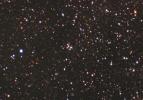
Photo by Steve Luzader
M29 in Cygnus. This is a piggyback photo using a 300 mm lens
at f/5.6. The exposure was 10 minutes on Fujicolor 800 film.
The displayed image is cropped from the original negative. (This
photo was taken on October 28, 2000. I found out a few days later
that while I was glued to the telescope taking pictures, I missed a fairly
bright aurora. I did manage accidentally to capture a faint aurora
on film, however. That photo is in the "Startrails" group.)
 Photo by Steve Luzader
Photo by Steve Luzader
M31 (the Andromeda Galaxy), M32, and M110 as seen from my driveway. The exposure
was 40 minutes on Fujicolor 200 film. The picture was taken with an 80 mm
f/5 Orion "ShortTube" refractor riding piggyback on a Celestron 8" SCT. Guiding
was done by viewing a star through the 8" with a 9 mm reticle eyepiece. The
original image was scanned from a print. I rescanned
the negative and processed the image with "flat field" technique
used on the photo of Antares and M4 above. This is the impressive result.
 Photo
by Steve Luzader
Photo
by Steve Luzader
M33 in Triangulum as seen from my driveway. This was a 40 minute piggyback
exposure Fujicolor 200 film taken with a 300 mm lens at f/5.6. Clicking
on the thumbnail shows a composite of the original frame as seen by the
camera plus an enlargement of the image of the galaxy itself.
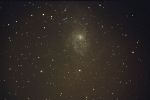 Photo
by Steve Luzader
Photo
by Steve Luzader Here's M33 photographed with my 8-inch SCT at f/6.3. The exposure was 30 minutes on Fujicolor Superia 400 negative film. The telescope was guided by my STV.
 Photo
by Steve Luzader
Photo
by Steve Luzader M35 in Gemini. This is a piggyback photo using a 300 mm telephoto lens at f/5.6. The exposure was 10 minutes on Fujichrome Sensia 100 slide film.
 Photo by Steve Luzader
Photo by Steve Luzader
M40 in Ursa Major. The object is the double star in the upper right corner
of the image. The exposure was 10 minutes on Fujicolor Superia 400 negative
film with my 8-inch SCT operating at f/6.3. The sky conditions were very poor,
and the image was enhanced using Paint Shop Pro.
 Photo
by Rob Himmler
Photo
by Rob Himmler
The sword of Orion with the famous Orion Nebula glowing at its center. The
exposure was 25 minutes on Ektrachrome 100 slide film with a 120 mm wide field
refractor at f/4.
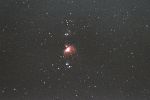 Photo
by Steve Luzader
Photo
by Steve Luzader The sword of Orion showing M42, the Orion Nebula. This 4.5 minute piggyback exposure was made from my driveway with a 300 mm lens set at f/8 on Konica 3200 negative film.
 Photo
by Gus Johnson
Photo
by Gus Johnson
The belt and sword of Orion. M42 (the Orion Nebula) can be seen near the bottom left of the image and the nebulosity containing IC343 (the Horsehead Nebula) is visible just below Alnitak, which is directly above M42 in the photo. The exposure was approximately 30 seconds with a 135 mm lens at f/2.8 on ISO 400 film. Altazimuth tracking was used.
 Photo
by Art Winter
Photo
by Art Winter
This CCD image of M42 was made using an SBIG ST-6 CCD camera attached to a
Tele Vue 4-inch refractor.
 Photo by Steve Luzader
Photo by Steve Luzader
M42 (the Orion Nebula). The exposure was 10 minutes on Kodak MAX 400 negative
film with my 8-inch SCT operating at f/6.3. The exposure was autoguided by
my STV.
 Photo
by Steve Luzader
Photo
by Steve Luzader
M44 (the Beehive Cluster) as seen from my driveway. Piggyback exposure on
Fujichrome 100 slide film.
 STV
image by Steve Luzader
STV
image by Steve Luzader
M51, the Whirlpool Galaxy. This is a track and accumulate composite of four
60-second exposures with my STV imager on my 8" SCT at f/6.3. The STV
image was enhanced using AIP4Win.
 Photo
by Steve Luzader
Photo
by Steve Luzader
A color photo of M51, the Whirlpool Galaxy in Ursa Major. The exposure was
30 minutes on Fujicolor Superia 400 negative film with my 8-inch SCT operating
at f/6.3. Unfortunately, the RA drive is failing in the telescope, and the
elongated star images are caused by the malfunctioning drive.
 Photo
by Steve Luzader
Photo
by Steve Luzader
The globular cluster M56 in Lyra. This was a 15 minute exposure on Fujicolor
Superia 400 color negative film with an 8" SCT at f/10. The telescope
was being guided by my STV imager/autoguider using the STV's 1-inch f/4 "E-finder"
as a guide scope. I did not do a careful polar alignment of the 8-inch. The
displayed image was cropped from the 35 mm negative and appears considerably
larger than it would if the entire frame were shown.
 Photo
by Steve Luzader
Photo
by Steve Luzader
M57 (the Ring Nebula). This 30 minute exposure was my first attempt at using
my STV as an autoguider. I used Fujicolor Superia 400 color negative film
with an 8" SCT at f/10. The telescope was being guided using the STV's
1-inch f/4 "E-finder" as a guide scope. I did not do a careful polar
alignment of the 8-inch, so the star images are elongated. The displayed image
was cropped from the 35 mm negative and appears considerably larger than it
would if the entire frame were shown. Compare this color image with the B&W
CCD image below. The green is due to oxygen in the gas cloud, while the red
comes from hydrogen.
 STV
image by Steve Luzader
STV
image by Steve Luzader
An STV image of M57. The image was made with my SBIG STV camera. It's a track-and-accumulate
composite of three 20 second exposures taken with an 8-inch SCT at f/6.3.
The camera was set for "Zoom" display mode.
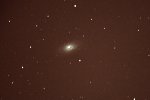 Photo
by Steve Luzader
Photo
by Steve Luzader
M64 (the Black Eye Galaxy). The exposure was 30 minutes on Fujicolor Superia
400 negative film with my 8-inch SCT operating at f/6.3. The exposure was
autoguided by my STV. This is a huge enlargement from the negative.
 STV
image by Steve Luzader
STV
image by Steve Luzader
M71 in Sagitta. This is a track and accumulate composite of six 20-second
exposures with my STV imager on my 8" SCT at f/6.3. The STV image was
enhanced using AIP4Win.
 Photo
by Steve Luzader
Photo
by Steve Luzader Here's a color photo of M71 in Sagitta. The exposure was 20 minutes on Fujicolor Superia 400 negative film with my 8" at f/10. The telescope was being guided by the STV imager.
 Image by Steve Luzader
Image by Steve Luzader
M76 (the Little Dumbell Nebula) in Perseus. This is a series of five STV images
registered and combined using AIP4WIN. Final adjustments were made with Paint
Shop Pro.

Photo by Steve Luzader
M77 and NGC1105 in Cetus. This is a piggyback photo made with
a 300 mm lens at f/5.6. The exposure was 20 minutes on Fujicolor
800 film. The image displayed is a small section cropped from the
negative. NGC1105 is the small fuzzy patch below the two stars at
the top center of the image. M77 is the bright fuzzy patch near the
lower left corner of the image. Some of the spiral structure of M77
is visible even in this small image.
 Photo
by Steve Luzader
Photo
by Steve Luzader
M81 and 82 as seen from my driveway. The exposure was 20 minutes on Fujichrome
Sensia 100 slide film using my 80 mm (aperture) f/5 Orion "Short Tube" refractor
riding piggyback on my Celestron 8" SCT. The galaxies are the fuzzy patches
at the center of the image. M81 is on the right, and M82 is on the left. The
irregular shape of M82 can be discerned, even though the image is small. (The
small refractor slipped slightly during the exposure.)
 Image by Steve Luzader
Image by Steve Luzader
The open cluster M93. This STV image is a track and accumulate composite
of five 5-second exposures. While the image shows effects of poor polar alignment,
it's special to me because M93 was the only one of the Messier objects I had
not observed. Now I have seen them all!
 Photo
by Steve Luzader
Photo
by Steve Luzader
M95, a barred spiral in Leo. The exposure was 30 minutes on Fujicolor Superia
400 negative film with my 8-inch SCT operating at f/6.3. The exposure was
autoguided by my STV, and the image was enhanced using Paint Shop Pro. (This
is a huge enlargement from the negative.)
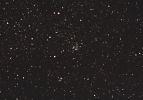
Photo by Steve Luzader
M103 in Cassiopeia. The piggyback exposure was 5 minutes on Fujicolor
800 film with a 300 mm lens at f/8. The photo was taken on October 28,
2000, during a fairly bright aurora. I missed the aurora because I was
taking pictures!
 STV
image by Steve Luzader
STV
image by Steve LuzaderM104 (the Sombrero Galaxy) in Corvus taken on at Tawes Hall on Astronomy Day 2001 (April 28, 2001). The image is a track and accumulate composite of ten 15-second exposures taken with my SBIG STV camera attached to an 8-inch SCT at f/6.3. The camera was set for "Wide" display mode, whose large (22.2 micron) pixels contribute to the grainy appearance of the image. The short exposures also cause the image to be a little noisy.
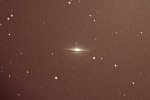 Photo by Steve Luzader
Photo by Steve Luzader
M104 (the Sombrero Galaxy). The exposure was 30 minutes on Fujicolor Superia
400 negative film with my 8-inch SCT operating at f/6.3. The exposure was
autoguided by my STV. This is a huge enlargement from the negative.
 Image by Steve Luzader. In the lower right corner we see M105 in Leo.
The other bright galaxy is NGC3388. This is an STV CCD image taken with
an 8" SCT. The image is a track and accumulate composite of 9 20-second
exposures.
Image by Steve Luzader. In the lower right corner we see M105 in Leo.
The other bright galaxy is NGC3388. This is an STV CCD image taken with
an 8" SCT. The image is a track and accumulate composite of 9 20-second
exposures.